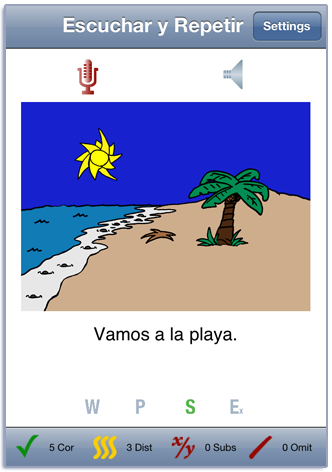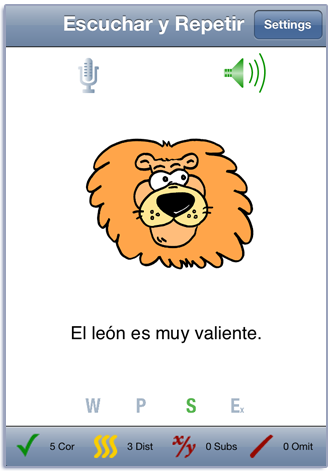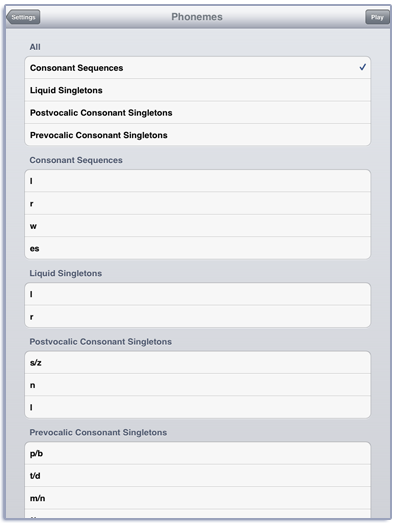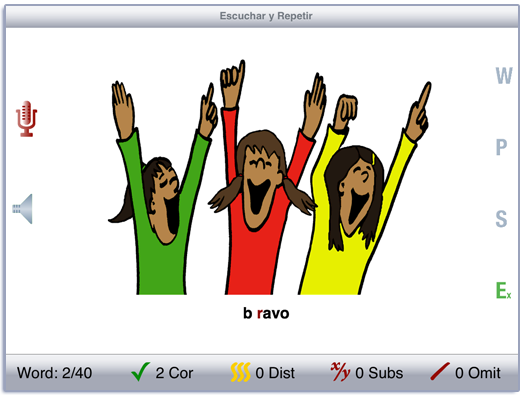Escuchar y Repetir—Spanish Phonology-Word Practice Manual
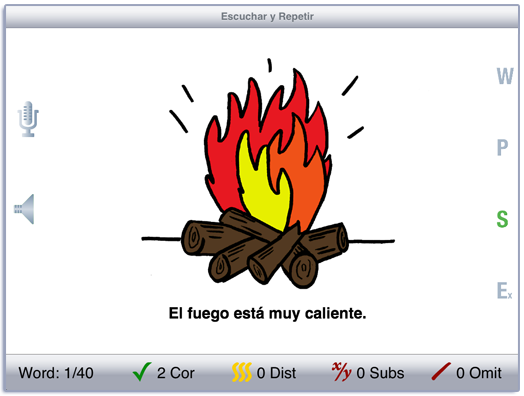
Contents
This app is based on the Word Practice game from LocuTour’s Spanish Phonology CD, Fonología en Español: Tratamiento. It uses a phonological approach to remediating speech that is adapted from the ideas of Hodson and Paden and based on the unique features of the Spanish Phonological System. The program focuses on target patterns rather than target phonemes. One pattern is targeted for a limited time—two to four weeks—then the next pattern is targeted. Hodson and Paden called this method of introducing patterns a “cycle”. Patterns include: Consonant Sequences, Liquid Singletons, Postvocalic Consonant Singletons, Prevocalic Consonant Singletons. Within these patterns, specific phonemes are targeted. Target sounds and sentences are recorded by a bilingual Speech-Language Pathologist.
Play
Tap the Play button to start. A picture is displayed on the screen. Each picture has a word, phrase, sentence, and the target phoneme exaggerated. To hear the word, tap the picture or tap the speech production button labeled W. In landscape view, the speech production buttons are on the right-hand side of the screen. In portrait view, they are at the bottom of the screen. The text of the speech production is shown below the picture. It can be hidden or displayed by toggling the button labeled “Show text below picture”, on the Options screen. Swipe right-to-left to move to the next word.
If your device is capable of recording, there will be a microphone and speaker on the screen. Tap the microphone to begin recording. After a short delay it will turn red. After it turns red, say the target word. Tap the microphone again and the speaker will turn green. Tap the speaker to hear the word played back.
Score the child’s speech production using the Spontaneous Correct, Spontaneous Incorrect, Imitative Correct, and Imitative Incorrect buttons at the bottom of the screen. If the word was pronounced correctly, tap the green check. If not, tap the red x. You can record and score as many times as you wish for each word.
If a sound is playing, the app will ignore taps to the picture and the speech production buttons.
Settings
You view the settings by tapping the Settings button at the top of the main game-play screen or at the bottom of the intro screen.
Pick a phonological process or processes from the Phonological Process option. If you are using the app for therapy, you’ll probably want to focus on just one process at a time. You can select all of the words from Consonant Sequences, Liquid Singletons, Postvocalic Consonant Singletons, and Prevocalic Consonant Singletons or you can pick pick specific patterns within these groups.
To view the word list, tap View Word List. You can download a list of the words and sentences from our website.
The Options tab lets you choose from three scoring methods by using the Choose Production Scoring Buttons toggle switch. The default in this app is to tally correct and incorrect responses that are Spontaneously produced (SpCor and SpInc) or Imitatively produced (ImCor and ImInc). You can switch to tallying correct, distorted, and incorrect responses (CDI) or correct, distorted, substituted, or omitted (CDSO) responses by using the buttons on the toggle switch.
You can sign in with the child’s name and the app will remember the name until you change it. If you enter a name, the results files will be stored with the name appended. e.g. Escuchar y Repetir Results Child One 2015-08-27.html
When you change the name a new file of results will be created. If you want to clear out the current results file, but not change the name, you can touch the Reset Scoring button.
The Results tab shows the results for the day. For each category (or group of categories), the app collects data on the total Visual Presentations (number of screens viewed), Spontaneous Correct and Incorrect productions, Imitative Correct and Incorrect productions, and the total Auditory Presentations. A new results file is created when you change the sign in name or when the day changes.
Viewing Results
You can email or print the results from the button at the top of the results page. The printed results include percentages as well as raw numbers for the speech responses. You may also use iTunes to copy the results files to your computer for annotating or archiving. To view the results pages in iTunes, plug your iPad or iPod into your computer. Open iTunes. Under Devices you’ll see your device. Click on the device and look at the top of the screen. You will see a tab labeled Apps. Under that tab, there is a section for File Sharing. The name and icon for this app will be displayed. In the documents list next to it you will find all of the results pages that are stored on the device. Drag them to your desktop. They will open in your web browser where you can print them.
Rationale
The phonological patterns included in this app were selected as a result of careful consideration of information from four primary sources: (1) the available literature on phonological development in various Spanish-speaking populations (Goldstein, 1995); (2) our own clinical experience as well as that of our students and colleagues who have worked with many Spanish-speaking children with speech delays; (3) the characteristics of the Spanish language itself, in terms of the frequency of occurrence of sounds and patterns; and (4) the recent recommendations of experts in the field regarding the selection of intervention targets when working with bilingual children (Yavas & Goldstein, 1998). The cumulative information from each of these four sources led to the inclusion of five broad categories of phonological patterns as well as eighteen subcategories on the Spanish Phonology CD: Consonant Sequences, Liquid Singletons, Postvocalic Consonant Singletons, Prevocalic Consonant Singletons. Four of these categories are included in this app—syllables are omitted. The skilled professional will be able to choose from these patterns to design an instructional program that is tailored to the needs of each child.
Credits
Created by Kathryn Kohnert, PhD, CCC/SLP with assistance from Marna Scarry-Larkin, MA, CCC-SLP and Elizabeth Price, MA, CCC-SLP. Graphics were originally drawn by Graham Rice and adapted for iOS by Nancy Scarry.
Screen Shots from iPhone and iPad
